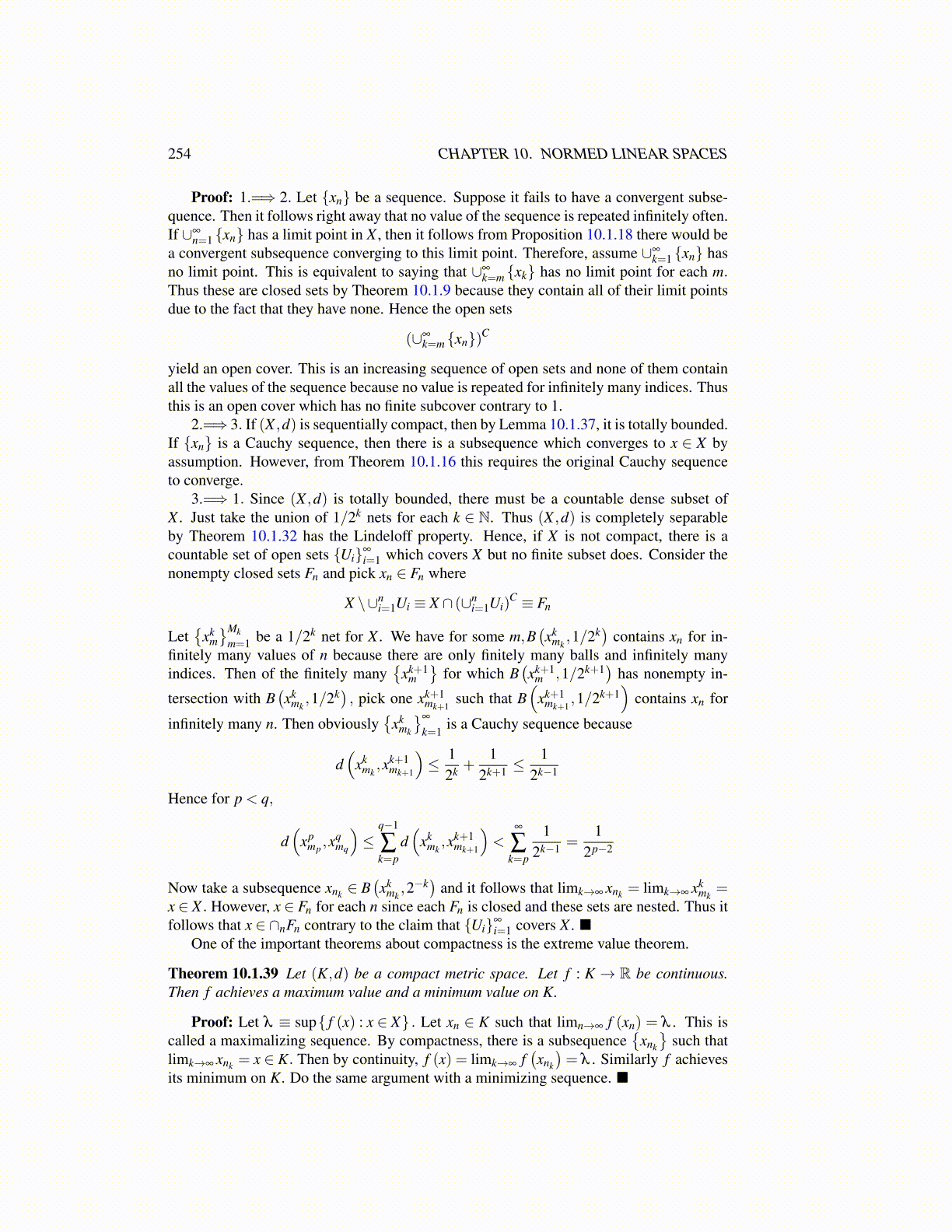
254 CHAPTER 10. NORMED LINEAR SPACES
Proof: 1.=⇒ 2. Let {xn} be a sequence. Suppose it fails to have a convergent subse-quence. Then it follows right away that no value of the sequence is repeated infinitely often.If ∪∞
n=1 {xn} has a limit point in X , then it follows from Proposition 10.1.18 there would bea convergent subsequence converging to this limit point. Therefore, assume ∪∞
k=1 {xn} hasno limit point. This is equivalent to saying that ∪∞
k=m {xk} has no limit point for each m.Thus these are closed sets by Theorem 10.1.9 because they contain all of their limit pointsdue to the fact that they have none. Hence the open sets
(∪∞k=m {xn})C
yield an open cover. This is an increasing sequence of open sets and none of them containall the values of the sequence because no value is repeated for infinitely many indices. Thusthis is an open cover which has no finite subcover contrary to 1.
2.=⇒ 3. If (X ,d) is sequentially compact, then by Lemma 10.1.37, it is totally bounded.If {xn} is a Cauchy sequence, then there is a subsequence which converges to x ∈ X byassumption. However, from Theorem 10.1.16 this requires the original Cauchy sequenceto converge.
3.=⇒ 1. Since (X ,d) is totally bounded, there must be a countable dense subset ofX . Just take the union of 1/2k nets for each k ∈ N. Thus (X ,d) is completely separableby Theorem 10.1.32 has the Lindeloff property. Hence, if X is not compact, there is acountable set of open sets {Ui}∞
i=1 which covers X but no finite subset does. Consider thenonempty closed sets Fn and pick xn ∈ Fn where
X \∪ni=1Ui ≡ X ∩ (∪n
i=1Ui)C ≡ Fn
Let{
xkm}Mk
m=1 be a 1/2k net for X . We have for some m,B(xk
mk,1/2k
)contains xn for in-
finitely many values of n because there are only finitely many balls and infinitely manyindices. Then of the finitely many
{xk+1
m}
for which B(xk+1
m ,1/2k+1)
has nonempty in-
tersection with B(xk
mk,1/2k
), pick one xk+1
mk+1such that B
(xk+1
mk+1,1/2k+1
)contains xn for
infinitely many n. Then obviously{
xkmk
}∞
k=1is a Cauchy sequence because
d(
xkmk,xk+1
mk+1
)≤ 1
2k +1
2k+1 ≤1
2k−1
Hence for p < q,
d(
xpmp ,x
qmq
)≤
q−1
∑k=p
d(
xkmk,xk+1
mk+1
)<
∞
∑k=p
12k−1 =
12p−2
Now take a subsequence xnk ∈ B(xk
mk,2−k
)and it follows that limk→∞ xnk = limk→∞ xk
mk=
x ∈ X . However, x ∈ Fn for each n since each Fn is closed and these sets are nested. Thus itfollows that x ∈ ∩nFn contrary to the claim that {Ui}∞
i=1 covers X . ■One of the important theorems about compactness is the extreme value theorem.
Theorem 10.1.39 Let (K,d) be a compact metric space. Let f : K → R be continuous.Then f achieves a maximum value and a minimum value on K.
Proof: Let λ ≡ sup{ f (x) : x ∈ X} . Let xn ∈ K such that limn→∞ f (xn) = λ . This iscalled a maximalizing sequence. By compactness, there is a subsequence
{xnk
}such that
limk→∞ xnk = x ∈ K. Then by continuity, f (x) = limk→∞ f(xnk
)= λ . Similarly f achieves
its minimum on K. Do the same argument with a minimizing sequence. ■